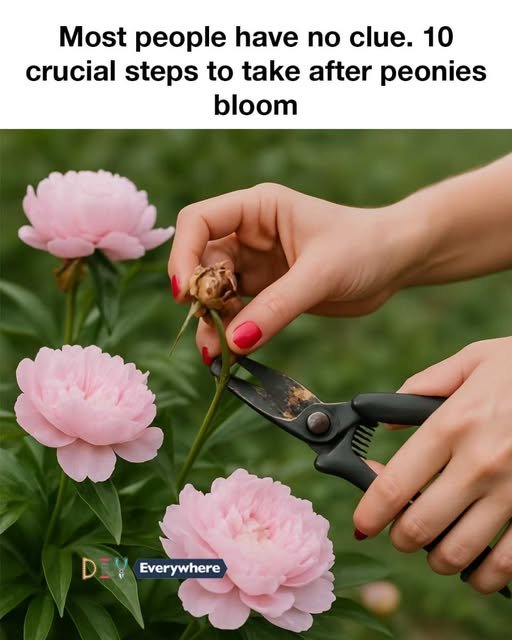Peonies are beloved for their lush, fragrant blooms that herald the arrival of spring and early summer. However, once these stunning flowers have had their moment in the sun, many gardeners are left wondering what steps to take next. Proper post-bloom care is essential to ensure that your peonies continue to thrive and produce beautiful flowers year after year.
Understanding the lifecycle of peonies and implementing a strategic care plan after they bloom can make a significant difference in their health and future flowering potential. This article outlines ten crucial steps to take after peonies bloom, providing you with the knowledge and tools needed to maintain a vibrant peony garden.
1. Understand the Peony Bloom Cycle
Peonies typically bloom in late spring to early summer, depending on the variety and climate. The bloom cycle lasts about 7 to 10 days, during which the flowers open fully and display their vibrant colors. Understanding this cycle is crucial because it helps you time your post-bloom care activities. After the blooms fade, the plant enters a period of growth and energy storage, which is vital for next year’s blooms. Recognizing the end of the bloom cycle allows you to begin the necessary care steps to support the plant’s health and future flowering potential.
2. Deadheading: The First Crucial Step
Deadheading is the process of removing spent blooms from the plant. This step is crucial because it prevents the plant from expending energy on seed production, redirecting it towards root and foliage development. To deadhead peonies, use a pair of clean, sharp scissors or pruning shears to cut the flower stem just above the first set of healthy leaves. This encourages the plant to focus on strengthening itself for the next growing season.
3. Fertilizing for Future Blooms
After the peonies have finished blooming, it’s an ideal time to fertilize them to promote healthy growth and prepare for next year’s blooms. Use a balanced, slow-release fertilizer, such as a 10-10-10 formula, applying it at a rate of about 1/4 cup per plant. Spread the fertilizer evenly around the base of the plant, being careful not to let it come into direct contact with the stems. Water the area thoroughly to help the nutrients penetrate the soil.
4. Watering Wisely: Post-Bloom Care
Proper watering is essential after peonies bloom to ensure they remain healthy and vigorous. Peonies require about 1 inch of water per week, either from rainfall or supplemental watering. Water deeply and infrequently to encourage deep root growth, which helps the plant withstand periods of drought. Avoid overhead watering, as wet foliage can lead to fungal diseases. Instead, water at the base of the plant early in the morning to allow the leaves to dry quickly.
5. Pruning: When and How to Do It
Pruning peonies after they bloom is an important step in maintaining their health and appearance. Once the blooms have faded, remove any dead or damaged stems to improve air circulation and reduce the risk of disease. In the fall, after the first frost, cut back the foliage to about 2 inches above the ground. This helps prevent diseases from overwintering in the plant debris and encourages healthy growth in the spring.
6. Pest and Disease Management
Peonies can be susceptible to pests such as aphids and diseases like botrytis blight. After blooming, inspect your plants regularly for signs of infestation or disease. Remove any affected foliage and dispose of it properly. For pest control, consider using insecticidal soap or neem oil, following the manufacturer’s instructions. To prevent disease, ensure good air circulation around the plants and avoid overhead watering.
7. Mulching for Moisture Retention
Applying a layer of mulch around your peonies after they bloom can help retain soil moisture and regulate temperature. Use organic mulch, such as shredded bark or straw, and apply it to a depth of about 2 to 3 inches. Be sure to keep the mulch a few inches away from the base of the plant to prevent rot and pest issues. Mulching also helps suppress weeds, reducing competition for nutrients and water.
8. Dividing Peonies: When It’s Necessary
Dividing peonies is not always necessary, but it can be beneficial if your plants have become overcrowded or are not blooming as vigorously. The best time to divide peonies is in the fall, after the foliage has died back. Carefully dig up the plant and use a sharp knife to divide the root clump into sections, each with at least 3 to 5 eyes (buds). Replant the divisions at the same depth they were growing before, and water them well to help them establish.
9. Preparing Peonies for Winter
Preparing your peonies for winter is crucial to protect them from harsh weather conditions. After cutting back the foliage in the fall, apply a layer of mulch to insulate the roots and protect them from freezing temperatures. In colder climates, consider covering the plants with a breathable fabric or burlap for added protection. Avoid using plastic, as it can trap moisture and lead to rot.
10. Soil Testing and Amendments
Testing your soil after peonies have bloomed can provide valuable insights into its nutrient content and pH level. Use a soil test kit to determine if any amendments are needed. Peonies prefer slightly acidic to neutral soil with a pH of 6.0 to 7.0. If your soil is too acidic, consider adding lime to raise the pH. Conversely, if it’s too alkaline, sulfur can help lower the pH. Adjusting the soil’s nutrient balance can improve plant health and flowering.
11. Planning for Next Season’s Blooms
Planning for next season’s peony blooms involves evaluating the current year’s performance and making any necessary adjustments. Consider factors such as bloom size, color, and plant health. If certain varieties performed better than others, you might want to propagate those or try new varieties that complement your garden. Keep a garden journal to track your observations and any changes you make, which can be invaluable for future planning and ensuring a beautiful peony display year after year.



